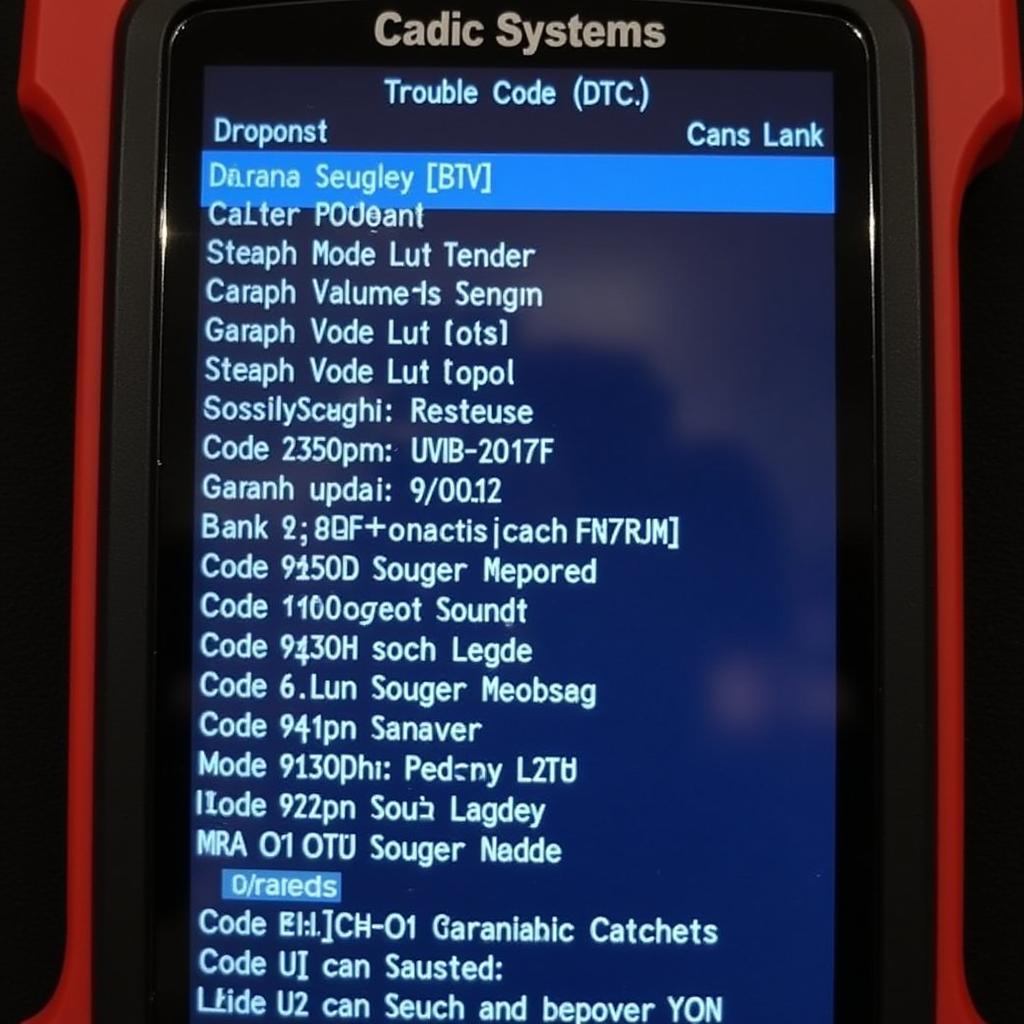A Diagnostic Trouble Code, or DTC as it’s more commonly known, is a string of alphanumeric characters that indicates a specific problem area in a vehicle. When a vehicle’s onboard computer detects a malfunction in a sensor, system, or component, it generates a DTC and stores it in its memory. Think of DTCs as your car’s way of telling you, “Hey, something’s not right here!”
These codes are an essential part of vehicle diagnostics, providing technicians and car owners with valuable insights into potential issues. Understanding what DTCs are and how to interpret them can be immensely helpful in diagnosing and repairing your vehicle effectively.
 DTC codes displayed on a scan tool screen
DTC codes displayed on a scan tool screen
How Do Scan Tools Retrieve DTCs?
A scan tool, also known as an OBD-II scanner, acts as the communication bridge between your car’s computer and you. It allows you to tap into the vehicle’s internal network and retrieve the stored DTCs. When you connect a scan tool to your vehicle’s OBD-II port (usually located under the dashboard on the driver’s side), it can access the DTCs stored in the vehicle’s computer.
Different types of scan tools are available, ranging from basic code readers to advanced professional-grade scanners. Basic code readers can retrieve and display DTCs, while more advanced scanners offer additional features like live data streaming, bi-directional control, and special functions for specific vehicle makes and models.
Deciphering the Code: Understanding DTC Structure
A DTC typically consists of five characters: a letter followed by four digits. Let’s break down the structure of a DTC:
-
First Character (Letter): This letter represents the system related to the code. Here are some common system codes:
- P: Powertrain (Engine, Transmission, Emissions)
- B: Body (Airbags, Power Seats, Central Locking)
- C: Chassis (ABS, Traction Control, Steering)
- U: Network & Communication (Modules, Wiring)
-
Second Character (Digit):
- 0: Standardized code (SAE – Society of Automotive Engineers)
- 1: Manufacturer-specific code
-
Third Character (Digit): This digit pinpoints the specific subsystem within the broader system category. For example:
- 1: Fuel and Air Metering
- 2: Fuel and Air Metering (Injector Circuit)
- 3: Ignition System or Misfire
- 4: Auxiliary Emissions Controls
- 5: Vehicle Speed Control and Idle Control System
- 6: Computer Output Circuit
- 7: Transmission Control
- 8: Transmission Control
-
Fourth & Fifth Characters (Digits): These two digits identify the particular problem or circuit within the subsystem.
For instance, a DTC of P0301 would indicate a powertrain (P) code, using the SAE standard (0), related to the ignition system or misfire (3), and specifically pointing to Cylinder 1 misfire (01).
Why Are DTCs Important?
DTCs play a crucial role in vehicle diagnostics by:
-
Early Problem Detection: They often appear before noticeable symptoms arise, enabling proactive maintenance.
-
Efficient Troubleshooting: They provide technicians with a starting point for diagnosis, narrowing down the potential problem areas and saving time and effort.
-
Cost Savings: By identifying specific issues, DTCs can prevent unnecessary repairs and replacements.
-
Improved Vehicle Performance and Safety: Addressing DTCs promptly can help maintain optimal vehicle performance and ensure safety by addressing potential hazards.
 A mechanic using a scan tool to diagnose a car problem
A mechanic using a scan tool to diagnose a car problem
Limitations of DTCs
While DTCs are valuable tools, it’s essential to understand their limitations:
-
Not a Magic Bullet: They indicate a problem area but don’t necessarily pinpoint the exact cause. Further diagnosis is often required.
-
Possibility of False Codes: Sensor malfunctions, loose connections, or temporary glitches can trigger false DTCs.
-
Need for Proper Interpretation: Misinterpreting DTCs can lead to incorrect repairs. It’s crucial to consider the vehicle’s history, symptoms, and other relevant data.
DTCs and the DIY Mechanic
For car owners who prefer a hands-on approach, understanding and utilizing DTCs can be empowering. Here’s how you can use DTCs for DIY car repair:
-
Invest in a Scan Tool: Choose a diagnostic scan tool reviews that suits your budget and needs.
-
Read the Codes: Connect the scan tool to your vehicle’s OBD-II port and follow the instructions to retrieve the DTCs.
-
Research the Codes: Numerous online resources provide detailed information about specific DTCs, including possible causes and repair suggestions.
-
Diagnose Carefully: Remember, DTCs are clues, not definitive answers. Use your knowledge, common sense, and research to diagnose the problem thoroughly.
-
Prioritize Safety: If you’re unsure about any aspect of the repair process, consult a qualified mechanic.
Conclusion
DTCs are an essential aspect of modern vehicle diagnostics, providing valuable insights into potential problems. Understanding how to interpret these codes can empower car owners and technicians to diagnose and address issues effectively, ensuring smoother rides and safer journeys. If you are uncomfortable working on your own vehicle, contact the professionals at ScanToolUS. We are here to help! We can be reached at +1 (641) 206-8880 or stop by our office located at 1615 S Laramie Ave, Cicero, IL 60804, USA.

